Bulk-generate & schedule posts in seconds with Smart Scheduling. Try now!
Social media marketing for small businesses: A step-by-step guide

Social media platforms have emerged as one of the best marketing tools of the 21st century. They are a great leveler that provides massive marketing and financial opportunities to small and emerging businesses comparable to well-established enterprises.
Social media marketing for small businesses is important because these strategies are a chance to reach over 5 billion users across digital platforms.
You might have come across general online information about different social media marketing strategies and how to run a social media marketing campaign.
However, it is important to fine-tune your strategy to fit your business’s specific size and type.
Therefore, this comprehensive article aims to address the various aspects of social media marketing for small businesses, including its effectiveness and steps to crafting a successful marketing campaign.
So, let’s examine how you can use social media in your small business to stay relevant and profitable.
Simplified social media marketing for individuals & agencies.
Try ContentStudio for FREE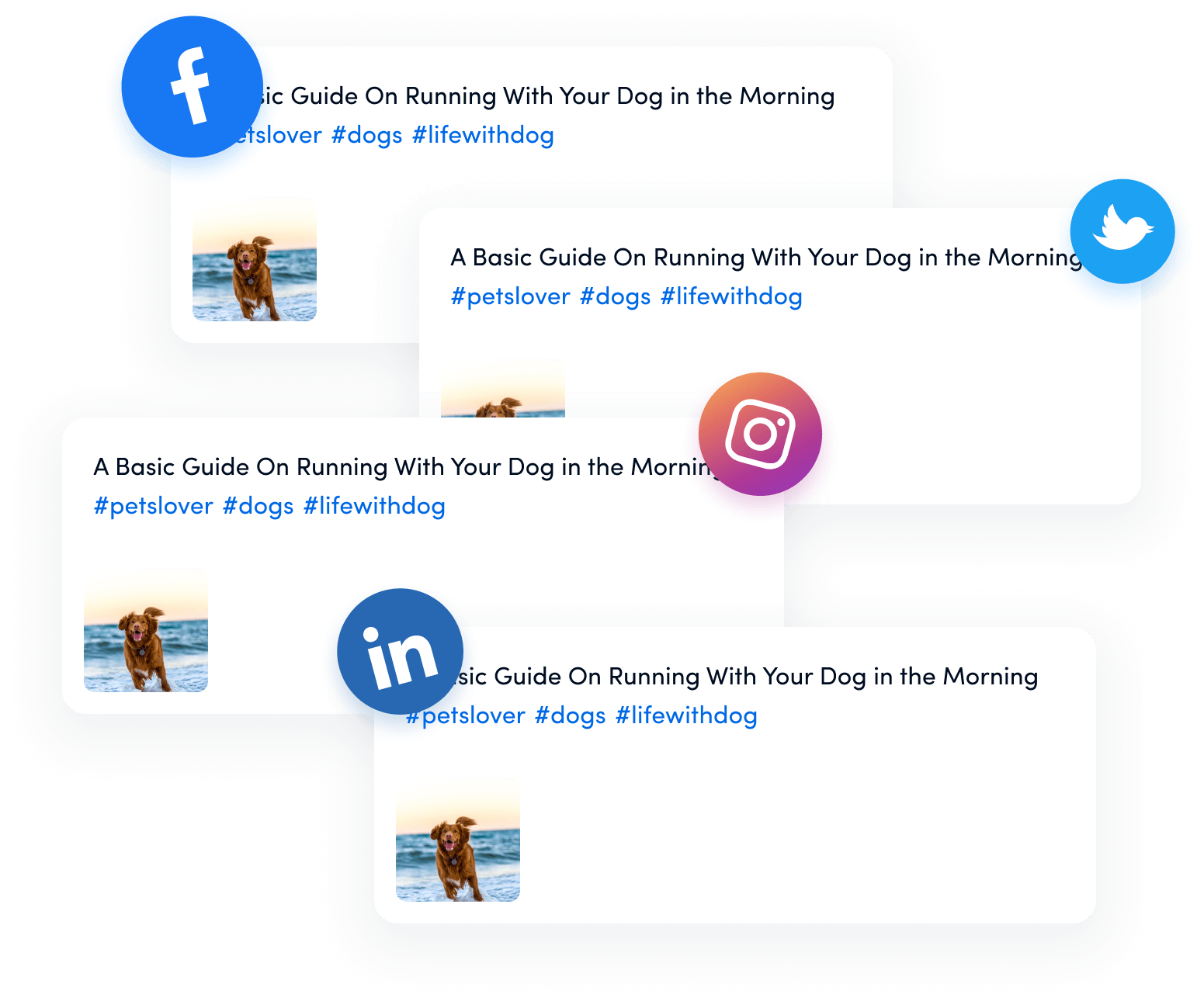
What is social media marketing?
Social media marketing posts content to your social media profiles to promote certain products, services, and overall brand.
While the crux of social media marketing is to advertise, it also involves building a loyal community of customers and potential customers for your small business.
A well-crafted social media marketing strategy involves regularly posting high-quality content and running ads, if possible, on social media platforms to reach a wider audience. Tracking and analyzing the progress of such efforts is also an integral part of social media marketing. Facebook, Instagram, TikTok, and YouTube are some of the most prominent platforms that are beneficial for small businesses’ social media marketing.
Following is an example of a paid social media marketing ad:
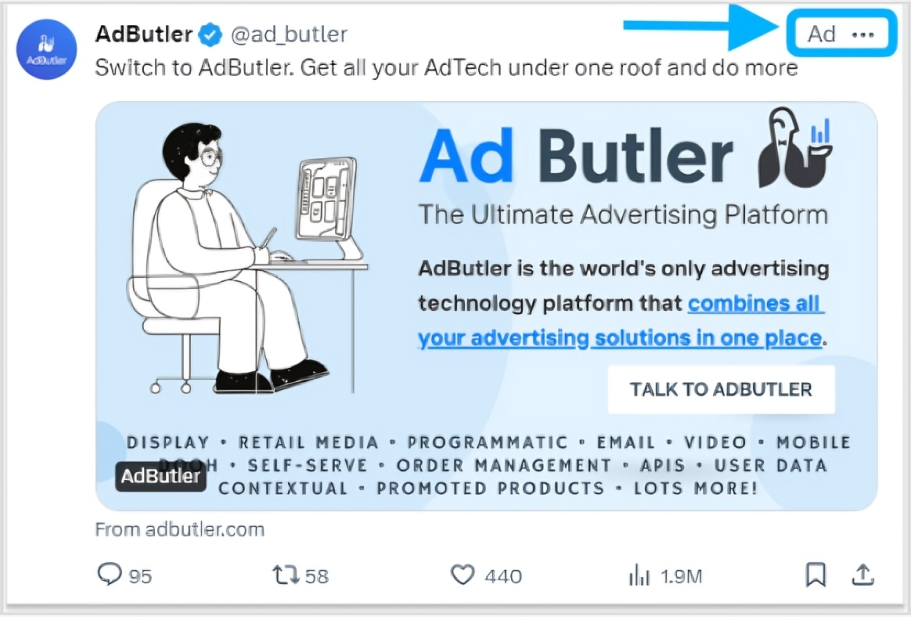
Importance of social media marketing for small businesses
Whenever a question about a new advertising or marketing strategy like social media pops up, you will likely ask yourself, ‘Why should I use social media marketing for my business?’
The answer is simple: better brand awareness, strong customer relationships, greater sales, and more profits.
Let’s see what other benefits you can achieve for your small business through social media marketing:
- Cost-Effective marketing: Let’s be real. Small businesses are always watching their budgets. The good thing is social media marketing is super affordable—you can get started for next to nothing, and even paid ads won’t break the bank.
- Increase brand awareness: Billions of people are hanging out on social media. Regular posts mean more eyeballs, which translates into more potential customers, thanks to your unique brand identity.
- Direct customer interaction: Social media gives you a direct line to your audience. You can chat with them in real-time, which builds that all-important trust and loyalty.
- Better customer insights: Pay attention to social media, and you’ll learn a ton about what makes your audience tick. Use those insights to shape your products and services to fit their needs perfectly.
- Targeted advertising: Modern social platforms know how to get specifics. You can put your ads right before the demographics you’re after. Better targeting means higher chances of people actually taking action.
- Improve customer service: Did customers get a complaint? Address it quickly on social media. Publicly resolving issues shows the world you care.
- Boosts website traffic: Share your content on social and watch the traffic to your website go up. More visitors means more potential sales.
- Analyze your competitors: Social media is a great tool for analyzing and learning how they optimize their profiles. Comprehensive competitor analysis can help you craft successful social media marketing strategies.
- Competitive advantage: Many small businesses are still not on social media or struggle with challenges related to different social media platforms. You can get ahead by leveraging effective social media marketing strategies.
- Builds brand authority: Keep posting quality stuff and engaging with your audience, and you’ll build serious authority in your industry.
- Encourages word-of-mouth marketing: Social media makes it easy for satisfied customers to share your posts. That helps your reach go off the charts. And you know word-of-mouth recommendations are straight-up powerful for an emerging small business.
Related Read: A complete guide on growth marketing – Top tactics & examples
How to use social media marketing for small businesses?
Now that you are familiar with the numerous benefits of social media marketing for a small business, you are probably wondering how you can take advantage of them.
Remember that using social media marketing for a small business is much more than just making regular posts or adding hashtags to your posts. Instead, it involves following a systematic process to ensure maximum success.
An effective social media marketing campaign for a small business can be broken down into 11 steps. Here’s a summary of these steps, along with some examples:
| Step Number | Step Name | Objective | Example |
| 1 | Set SMART social media goals | Define Specific, Measurable, Achievable, Relevant, and Time-bound objectives. | Set a goal to increase Instagram followers by 10% within three months by posting engaging content and running a small ad campaign. |
| 2 | Analyze your target audience | Understand who your audience is, their interests, demographics, and online behavior. | Use ContentStudio to identify the primary age group and interests of your audience. |
| 3 | Conduct social media competitor analysis | Research your competitors’ social media strategies, strengths, and weaknesses. | Identify competitors’ most engaging content. |
| 4 | Find your brand voice | Develop a unique voice and style that aligns with your brand’s identity and resonates with your audience. | Develop a friendly and informative tone for your brand. |
| 5 | Select the right social media platforms | Choose platforms where your target audience is most active, and your content will perform best. | Focus on Instagram and LinkedIn for B2B marketing. |
| 6 | Create a social media content plan | Develop a content calendar outlining what and when to post. | Plan weekly posts covering industry news and tips. |
| 7 | Create high-quality content | Produce engaging and valuable content that appeals to your audience and represents your brand. | Share high-resolution photos of your products, behind-the-scenes videos, and customer testimonials to showcase your brand’s personality and offerings. |
| 8 | Schedule posts strategically | Post at optimal times for maximum engagement and consistency. | Use ContentStudio to schedule posts during peak hours when your audience is most active. |
| 9 | Engage with your audience | Interact with your followers by responding to comments, messages, and mentions promptly. | Reply to customer inquiries within 24 hours. |
| 10 | Run social media ads | Utilize paid advertising to reach a broader audience and achieve specific goals. | Launch a targeted Facebook ad campaign promoting a limited-time offer. |
| 11 | Analyze and adapt your strategy | Review performance metrics and adjust your strategy as needed. | Increase ad budget for high-performing campaigns. |
Let’s dive deep into each of these steps one by one so you can effectively use social media marketing for a small business:
Step # 1 – Set SMART social media goals
So, you are ready to dive into social media marketing opportunities now, right? But before you start posting content and using different hashtags, you should have clear goals in mind to ensure maximum success.
Defining your social media goals will lay the foundation of your entire marketing strategy for your business. Moreover, you will be able to refer back to these goals at a later stage to analyze and measure your progress.
Think of it like planning a road trip. You wouldn’t just get in the car and start driving, would you? You’d have a destination in mind, right?
The same goes for social media.
Here’s where the SMART strategy comes in. It’s an acronym that helps you set goals that are:
- Specific: Your goals should be clear and specific. Avoid vague objectives. Instead of saying, “I want more followers,” specify, “I want to increase my Instagram followers by 20%.”
- Measurable: You need to track your progress to determine whether your social media strategy is working. A measurable goal helps you see if you’re on the right path. For instance, if you aim to boost your followers, set a numerical target. We’ll look at other key measurable social media marketing metrics like follower growth, website clicks, and engagement rates in the later section of this blog.
- Achievable: Being ambitious is great, but you must set realistic goals, especially when using social media marketing for a small business with a limited budget. If you’re starting from scratch, aiming for a million followers in a month isn’t feasible. Instead, set a target that’s challenging yet reachable within your niche.
- Relevant: Ensure your social media goals align with your overall business objectives. Are you trying to boost brand awareness, drive sales, or generate leads?
- Time-bound: Set a deadline for your goals. This adds a sense of urgency and helps you stay focused. Instead of saying, “I want more followers,” you can say, “I want to increase my Facebook followers by 30% in three months.”
By following the SMART strategy and tailoring the goals to your business’s niche, you can have clear and achievable goals to guide your social media marketing efforts.
These goals provide a clear roadmap and help you stay focused. Remember, setting SMART goals is not a one-time task. Regularly review and adjust your goals to keep up with changes and new opportunities.
Once you have set SMART goals, you can move to the next step!
Step # 2 – Analyze your target audience
Just because there are billions of users on social media does not mean that you have to cater to the majority of them. Instead, micro-targeting a niche audience can translate into greater and faster business success. It all comes down to the niche in which you are operating it.
You can better understand the significance of audience analysis in social media marketing with this example:
Imagine you’re at a party. You wouldn’t walk up to everyone and talk about the same thing, would you? You’d find the people who share your interests, right?
Social media is similar. To connect with the right people, you need to start by creating buyer personas that represent your ideal customers. Key things you should include in buyer personas are:
- Demographics: Age, gender, location, education level, occupation, interests, and pain points can give you a basic picture of your ideal customer.
- Psychographics: This goes beyond demographics and dives into your audience’s interests, values, lifestyles, and online behavior. What are they passionate about? What problems do they face?
- Social media habits: Where are they hanging out online? What type of content do they engage with on social media? For example, some audiences may prefer visual content on platforms like Instagram, while others may engage more with informative articles on LinkedIn. Understanding these habits will help you choose the right platforms and tailor your content accordingly.
There are many ways to gather this information.
You can start by brainstorming who your ideal customer is, then look at your existing customer base (if you have one).
Platform built-in tools like Facebook Business Suite can be used for audience analysis. Moreover, all-in-one social media analytics tools like ContentStudio can provide valuable insights into your audience demographics. We’ll look at these tools in detail later!
By taking the time to analyze your audience, you’ll be able to craft content that resonates with them and truly sparks a conversation.
Example of a buyer persona
The following is an example of a buyer persona for a small-scale jewelry business:
Name: Sarah Li
Age: 31
Occupation: Marketing Manager
Location: Urban area
Interests: Fashion, trends, luxury items
Income Level: Upper-middle class
Shopping Behavior: Regularly shops for high-quality accessories, follows fashion influencers on social media, prefers unique and handmade items, values personalized shopping experiences
Goals: To enhance her personal style with unique and elegant jewelry pieces, stay updated with the latest fashion trends, support local artisans
Challenges: Finding affordable yet high-quality jewelry, selecting pieces that complement her wardrobe, navigating through a variety of options available online
Preferred Channels: Instagram, Pinterest, boutique shops
Buying Triggers: Limited edition collections, personalized recommendations, discounts or promotions on exclusive designs
Considering this example, a jewelry business can turn Sarah into a loyal customer by offering personalized recommendations based on her style preferences and past purchases.
Moreover, the business can showcase limited edition collections or new arrivals, especially on Insagram and Pinterest, that align with Sarah’s taste in elegant and unique jewelry.
Step # 3 – Conduct social media competitors analysis
Once you have a clear idea of your own goals and target audience, it is time to gather information about your competitors. Think of it as peeking over their shoulder (in a friendly way, of course!).
Analyzing your competitors’ social media presence can provide valuable insights into industry trends, content strategies, and audience engagement tactics.
You should start this process by identifying your main competitors in the social media landscape.
Once you’ve identified your competitors, examine their social media profiles thoroughly. Look at the type of content they post, how often they post, the engagement they receive (likes, comments, shares), and the overall tone and style of their messaging.
Platforms like social media analytics tools and competitor analysis tools can streamline this process by providing data-driven insights into your competitors’ performance metrics.
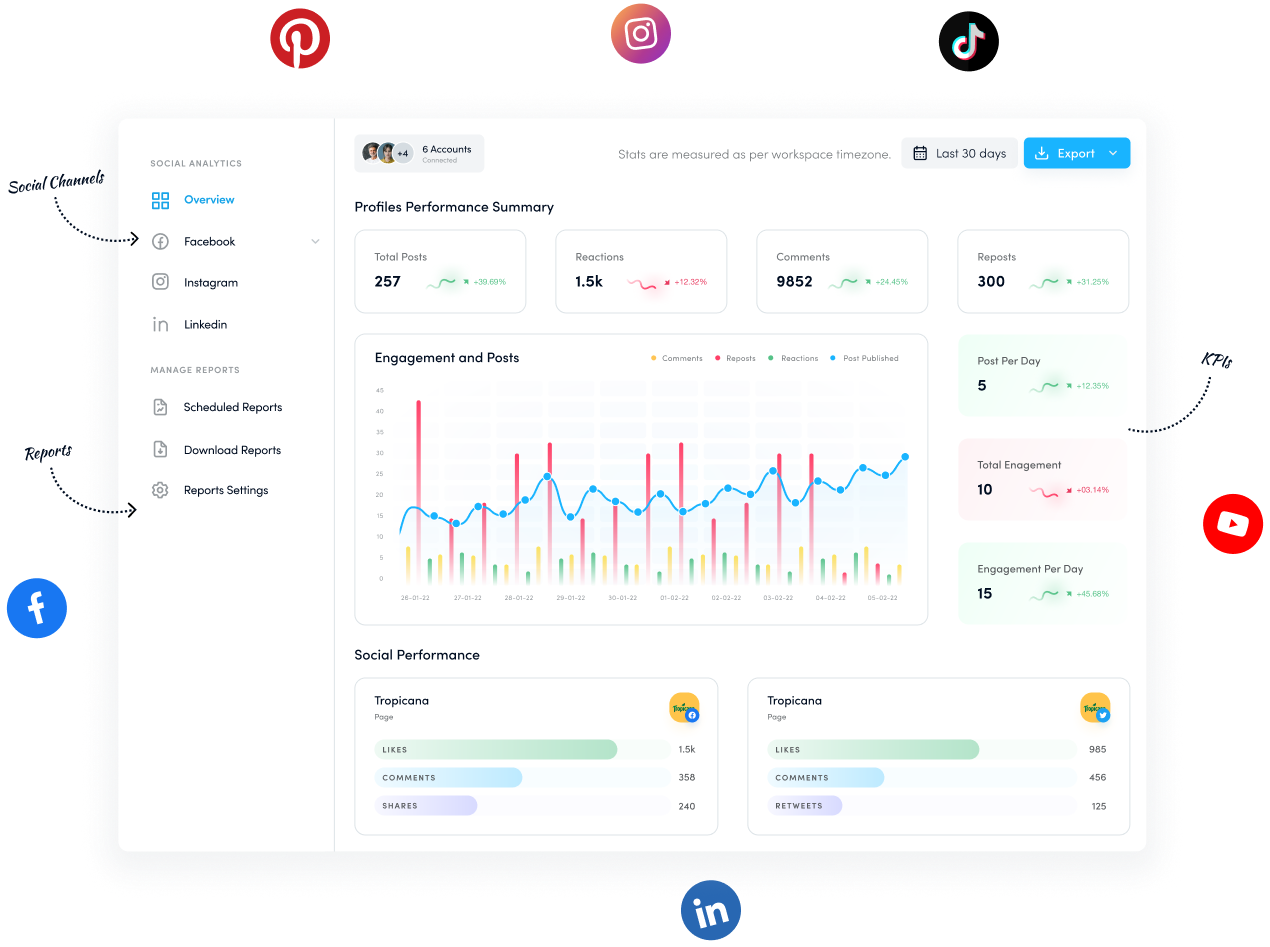
By the end of a comprehensive social media competitors analysis process, you will be able to obtain the following information:
- What’s working for them? See what kind of content your competitors are posting and how their audience is responding. Are they using visuals effectively? What types of posts generate the most engagement?
- What gaps can you fill? Are there areas where your competitors are falling short? Can you offer something unique or valuable that they’re not?
- Industry trends: Get a sense of what’s popular in your industry on social media. Are there any trends you can tap into?
Remember, the goal of the competitor’s analysis is to learn from their successes and failures. You should use these findings to develop your brand voice and outsmart your competition with a refined social media marketing strategy for your business.
Step # 4 – Find your brand voice
So far, you’ve nailed down your goals, identified your audience, and researched your competitors.
Now it’s time to develop your brand voice – the unique personality that will help you make your mark on social media.
Think of your brand voice as your way of having a conversation with your audience.
It’s how you express your brand’s values and personality and what makes you different. Do you want to sound friendly and approachable? Informative and authoritative? Perhaps with a touch of humor?
Here are some effective tips you can use to find your brand voice on social media:
- Reflect on your brand personality: Imagine your brand as a person. What are their traits? Are they playful and energetic, or sophisticated and elegant?
- Consider your audience: How do you want your audience to perceive you? What kind of tone would resonate with them?
- Test different approaches: Gather feedback from your audience to fine-tune your brand voice over time. Monitor engagement metrics to see which type of content resonates best with your audience and adjust your strategy accordingly. You can also use social media automation to build your brand voice.
- Analyze your existing content (if any): Look at your website copy, marketing materials, or even internal communications. Does a consistent tone or style emerge?
- Use strong verbs and vivid language: Bring your content to life with words that paint a picture and engage your audience.
- Be authentic: Don’t try to be someone you’re not. Your audience will appreciate your genuine voice and unique content related to your products and services.
The most important thing to remember about brand voice is that it is not set in stone. It can evolve over time as your brand grows. Yet, having a strong foundation will ensure your social media presence is consistent, memorable, and truly reflects the essence of your small business.
Step # 5 – Select the right social media platforms
With your brand voice locked and loaded, it’s time to decide where to establish your presence in the vast social media landscape.
While your first instinct will likely be creating accounts on all major social media platforms, you should remember that you don’t have to conquer every platform. The key is to be strategic and focus on the ones where your target audience hangs out.
How to select the right social media platform to market a small business?
Here are some factors to consider when choosing your social media platforms:
- Your audience demographics: Where does your ideal customer spend their time online? Are they on Facebook, or are they more likely to be scrolling through Instagram stories?
- Your content type: Consider the type of content you excel at creating. If you’re a visual brand with stunning photos and videos, Instagram and Pinterest might be a good fit. If you’re a B2B company focused on thought leadership, LinkedIn could be your champion.
- Your resources: Be realistic about the time and resources you can dedicate to social media management. Spreading yourself too thin across multiple platforms can lead to inconsistent posting and, ultimately, a less impactful presence.
Key strengths of popular social media platforms
If you have a clear understanding of your requirements and expectations from social media marketing, it becomes easier to select the right social media platform based on your individual strengths:
- Facebook: Great for a broad audience, community building, and advertising.
- Instagram: Ideal for visual content, lifestyle brands, and engaging younger audiences.
- Twitter: Perfect for real-time updates, customer service, and industry news.
- LinkedIn: Best for B2B marketing, professional networking, and thought leadership.
- Pinterest: Excellent for visual inspiration, DIY projects, and driving traffic to your website.
- TikTok: Ideal for short, engaging video content and reaching a younger demographic.
By carefully selecting the social media platforms that align with your business goals and audience preferences, you can maximize your reach and engagement, ultimately driving better results for your small business.
Step # 6 – Create a social media content plan
It’s time to craft the content that will engage your audience and help you achieve those goals.
But winging it on social media rarely leads to success.
That’s where a social media content calendar comes in – your roadmap to consistent and strategic social media posting.
A well-structured content plan is vital to ensuring brand consistency and aligning social media marketing efforts with business goals.
Here’s how a content calendar can help you:
- Stay organized: Plan your content in advance to avoid last-minute scrambling and ensure a consistent posting schedule.
- Maintain variety: To keep your audience engaged, include a mix of content formats, such as images, videos, blog posts, and even polls or quizzes.
- Align with holidays and events: Leverage national holidays, industry events, or special occasions to create timely and relevant content.
- Schedule promotional posts: Plan your social media promotions strategically to maximize their impact.
- Track and analyze results: Use your content calendar to track what’s working and not, allowing you to refine your strategy over time.
When creating your content calendar, consider these elements:
- Content themes: Identify key themes that resonate with your brand and audience.
- Content types: Experiment with different formats to see what resonates best.
- Posting schedule: Determine how often you’ll post on each platform and at what times.
- Call to action (CTA): Tell your audience what you want them to do after seeing your content, whether following your social media account, visiting your website, subscribing to your newsletter, or participating in a contest.
Ultimately, by taking the time to plan your content, you’ll ensure your social media presence is well-organized and engaging and that it drives results for your small business.
Step # 7 – Create high-quality content
The quality of your content can make or break the effectiveness of your social media marketing campaign for a small business. Once you have a content calendar brimming with ideas, it’s time to roll up your sleeves and create the social media content that will stop your audience in their mid-scroll.
Remember, quality is key! Grainy photos and poorly written captions won’t do much to grab attention.
Here are some tips you should follow to create appealing social media content:
- Visuals are everything: People are drawn to visually appealing content. Use high-quality photos, infographics, and videos to make your posts stand out.
Related Read: How to ace Instagram aesthetics for businesses?
- Write compelling captions: Don’t underestimate the power of words! Craft captions that are informative, engaging, and encourage interaction.
- Tell stories: People connect with stories. Use your content to showcase your brand personality, share customer testimonials, or take your audience behind the scenes of your business.
- Create valuable content: Every post should offer value to your audience. Whether informative, entertaining, inspiring, or evergreen content, it should offer something worthwhile.
- Be authentic: Let your brand’s unique voice shine through. Don’t be afraid to be yourself and connect with your audience on a personal level.
- Proofread everything: Typos and grammatical errors can make your brand look unprofessional. Double-check your content before hitting publish!
- Ensure consistency: Consistency in your posting schedule, brand voice, and visual style help reinforce your brand identity.
- Follow social media trends: Social media trends are always changing on a regular basis. You should keep an eye on the latest trends and adapt your content strategy accordingly. Incorporating trending topics and formats can help keep your content fresh and relevant.
Related read: How to become a pro at AI-generated content
Step # 8 – Schedule posts strategically
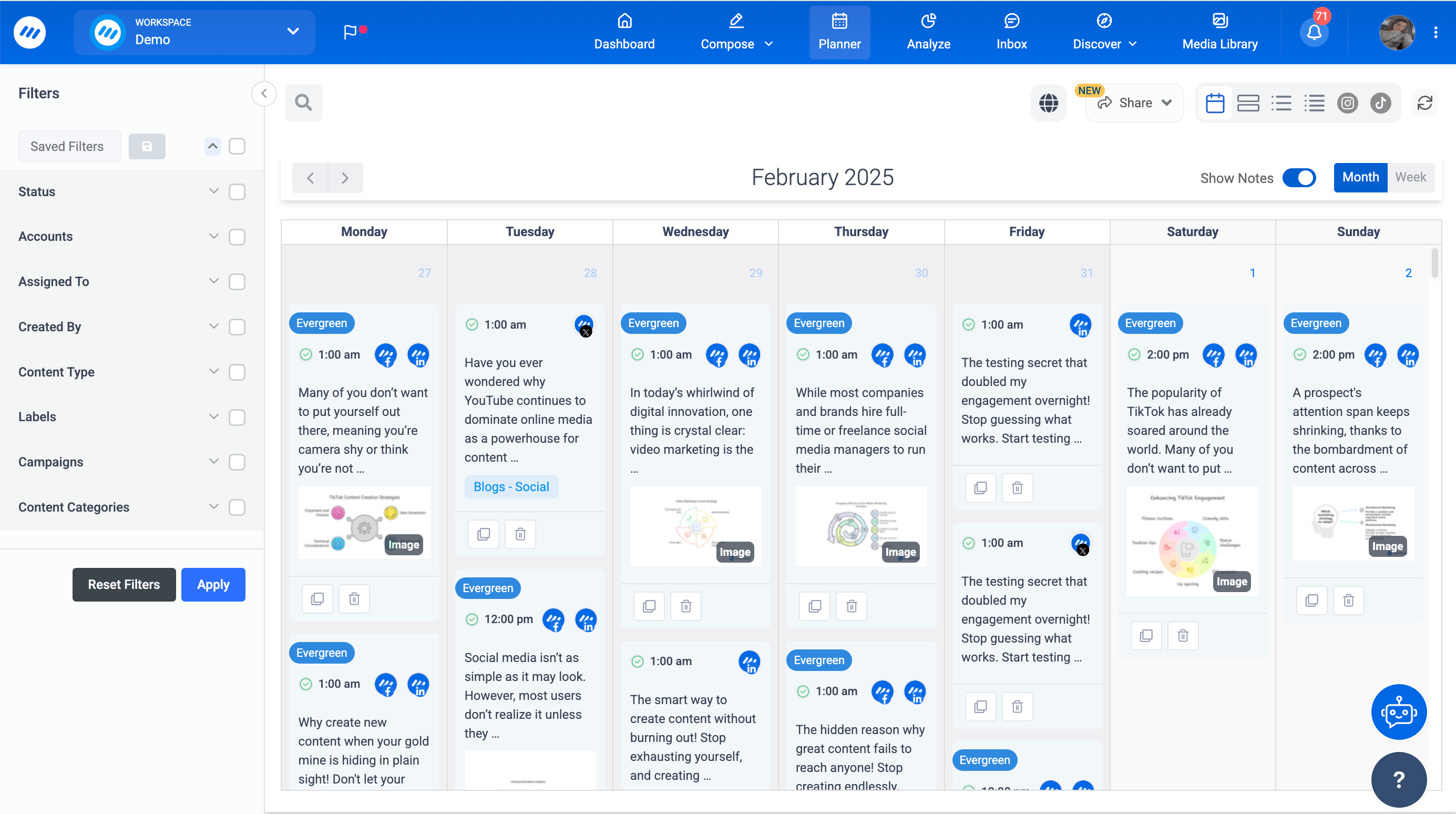
Once you have crafted ideal social media content, you are likely to itch to hit the post button.
But hold on a second!
Timing is everything when it comes to social media.
Strategically scheduling your posts ensures they reach your audience when they’re most active and engaged.
Here are some tips for strategic social media posting:
- Know your audience’s habits: When are your target audience members most likely to be scrolling through their social feeds? Research peak times for each platform and tailor your posting schedule accordingly.
- Consider time zones: If you have a global audience, consider scheduling some posts for off-peak hours in your own time zone to cater to viewers in different locations.
- Experiment and analyze: Track your engagement metrics to see what posting times resonate best with your audience. Don’t be afraid to experiment and adjust your schedule as needed.
- Utilize scheduling tools: Many social media platforms offer built-in scheduling features or integrate with third-party scheduling tools. These tools can save you time and ensure consistent posting.
By focusing on high-quality content that aligns with your brand voice and resonates with your audience, you’ll create a social media presence that captivates, converts, and helps your small business thrive.
Keeping all these factors in mind to determine the best time to post on various social media platforms can seem difficult.
So, ContentStudio has conducted its own study to find the best social media posting times. The summary of this study is as follows:
Here’s a tabulated version of the best times to post on various social media platforms in EST:
| Day | TikTok | ||||
| Monday | 2 PM to 4 PM and 10 AM | 6 AM, 10 AM and 10 PM | 4 PM and 7 PM | 12 PM to 1 PM and 4 PM | 2 PM to 3 PM and 7 PM |
| Tuesday | 1 PM and 3 PM | 2 AM, 4 AM and 9 AM | 7 PM | 9 AM to 11 AM and 1 PM | 2 PM to 3 PM and 5 PM to 6 PM |
| Wednesday | 4 PM, 6 PM and 10 PM | 7 AM, 8 AM and 11 PM | 4 PM, 6 PM to 7 PM | 8 AM to 1 PM | 8 AM to 9 AM and 6 PM |
| Thursday | 12 AM and 10 AM | 9 AM, 12 AM and 7 PM | 12 PM, 6 PM to 7 PM | 11 AM and 5 PM | 2 PM and 10 PM |
| Friday | 6 PM and 2 PM | 5 AM, 1 PM and 3 PM | 6 PM to 8 PM and 4 PM | 11 AM and 1 PM | 2 PM and 5 PM |
| Saturday | 7 PM and 12 AM | 11 AM, 7 PM and 8 PM | 7 PM and 10 PM | 10 AM to 12 PM | 1 PM, 2 PM and 3 PM |
| Sunday | 10 AM and 3 PM | 7 AM, 8 AM and 4 PM | 6 AM to 7 AM and 5 PM EST | 11 AM, 4 PM to 5 PM and 5 PM | 6 PM and 10 PM |
By strategically scheduling your high-quality content, you’ll ensure it reaches the right people at the right time, maximizing your reach and engagement on social media.
Step # 9 – Engage with your audience
You’ve published fantastic content, and your social media presence is starting to buzz.
But social media is a two-way street! Here’s where the magic happens – engaging with your audience and building relationships beyond likes and comments.
Follow these tips to ensure maximum engagement with your audience:
- Prompt responses: Let your audience know their voices are heard. Respond to comments and messages in a timely and courteous manner, even if it’s just to say “thanks!”
- Address negative feedback: Responding to positive comments with gratitude is as important as responding to trolls or negative comments with your defense. You must handle negative comments and feedback calmly and professionally, offering solutions or assistance.
- Be authentic: Engage in a genuine and relatable manner. Avoid generic responses and aim for personalized interactions that reflect your brand’s personality.
- Encourage discussions: You can ignite conversations and encourage discussion among your followers by posing questions in captions or using features like polls. This is a great way to learn more about your audience and their interests.
- Arrange giveaways: Who doesn’t love a chance to win? Contests and giveaways are a fun way to generate excitement and encourage audience participation.
- Show gratitude: Thank your audience for their engagement and highlight user-generated content. This fosters loyalty and encourages further interaction.
- Go live!: Live video sessions offer a unique opportunity to connect with your audience in real time. Host Q&A sessions, product demos, or behind-the-scenes glimpses to add a personal touch.
- Share user-generated content: Highlight content created by your followers. Sharing user-generated content not only shows appreciation but also builds trust and authenticity. It encourages others to engage and contribute as well.
- Partner with influencers: Leverage social media influencers in your niche to reach a wider audience and gain credibility.
Engagement is ultimately the heart of social media marketing, driving deeper connections and long-term success.
Following the above tips, you can actively engage with your audience, build stronger relationships, foster loyalty, and create a thriving social media community around your small business.
Step # 10 – Run social media ads
So far, you’ve mastered the art of organic social media marketing. But if you want to take your reach and engagement to the next level, consider incorporating social media advertising in your social media marketing strategy.
Here’s how social media ads can benefit your small business:
- Targeted reach: Social media advertising platforms allow you to target your ideal audience with laser precision based on demographics, interests, and behaviors. This ensures your message reaches the people most likely to be interested in your products or services.
Related: TikTok advertising: A complete guide to use TikTok ads
- Increased brand awareness: Paid ads can help you get your brand in front of a wider audience, even those not following you.
- Drive website traffic: Design your ads to lead users to your website or landing page, where they can learn more about your offerings and take a desired action, like purchasing or signing up for your newsletter.
- Choose the right Ad format: Social media platforms offer various ad formats, including image ads, video ads, carousel ads, and more. Select the format that best suits your campaign goals and content.
- Track and analyze results: Social media advertising platforms offer robust analytics tools that allow you to track the performance of your ads and see what’s working and what’s not. This valuable data helps you optimize your campaigns for maximum impact.
By combining organic social media strategies with targeted social media advertising, you can create a well-rounded social media presence that effectively reaches your target audience, builds brand loyalty, and ultimately helps your small business thrive in the digital age.
Step # 11 – Analyze and adapt your marketing strategy
First of all, congratulations!
If you have followed the above ten steps, you’ve implemented a comprehensive and effective social media marketing strategy for your small business.
But remember, social media is a dynamic landscape.
What works today might not work tomorrow. That’s why ongoing analysis and adaptation are key to sustained success.
Here’s how to stay ahead of the curve:
- Track your results: Monitor key metrics like follower growth, engagement rates, website clicks, and conversions. Use social media analytics tools and insights to understand what’s working and what’s not. Most importantly, compare your results with your SMART goals to measure your progress and judge the effectiveness of your existing marketing strategy.
- Identify top-performing content: Analyze which types of content resonate most with your audience. Look for patterns in high-performing posts to understand what works best. Use these insights to create more of what your audience loves.
- Stay informed about social media trends: Keep your finger on the pulse of the latest social media trends and platform updates. Are there new features you can leverage? Are there emerging content formats that resonate with your audience?
- Run A/B tests: Experiment with different approaches and see what resonates best with your audience. Test different post types, captions, visuals, and posting times to optimize your content strategy.
- Refine your audience targeting: As you gather more data, you can refine your audience targeting to ensure your content reaches the right people at the right time.
- Be adaptable: Don’t be afraid to adjust your social media marketing strategy based on what you learn. The key is to be data-driven and prioritize what works best for your small business and target audience.
By continuously analyzing your results and adapting your strategy, you’ll ensure your small business’s social media presence remains effective and delivers a strong return on investment.
So, keep learning, experimenting, and growing your social media presence!
Key social media marketing metrics
Once a social media marketing campaign is designed and deployed, different key performance indicators (KPIs) on various social media platforms come into play. These KPIs are important to evaluate the campaign results and determine if your current strategy is enough to reach the desired results.
Most social media platforms have built-in analytics tools, such as LinkedIn analytics. However, these tools provide limited information, so it is highly recommended you use a unified social media management tool like ContentStudio to track and measure key social media marketing metrics.
The exact social media metric can vary from platform to platform, but generally, ContentStudio’s comprehensive analytics features help you measure and track the following metrics:
| KPI | Description |
| Fans/Followers | The number of fans or followers you have on your page |
| Impressions | The number of times your posts or content were seen |
| Engagement | Total no. of actions performed on your posts/content |
| Reactions/Favorites | Reactions (likes, favorites) received by your shared posts |
| Clicks | Clicks received by the posts you share |
| Feedback | The feedback you received on the page |
| Sentiment | Positive and Negative sentiments received on your page |
| Message Count | Total number of messages received on the page |
| Audience Growth | Graph showing how your community is growing over time |
| Published Posts with Engagement | Total no. of posts published with their engagement |
| Post Rate | Total number of posts published by their type (videos, photos, links, etc.) |
| Post Density – Daily | Your post patterns on a daily basis. The data is updated approximately every hour |
| Page Impressions | Paid, organic, and viral Impressions |
| Video Analytics | Engagement for videos and click-to-play content |
| Engagement Rate | Actions committed on your shared posts |
| Engagement by time | See when your posts trigger the most engagement |
| Top Posts by Engagement | Posts that got the maximum engagement in chronological order |
| Retweets | Total no. of Retweets on your published tweets |
| Following | The number of people you’re following |
| Awareness through mentions | Number of tweets with your brand name, brand keywords, or links to your website |
| Top Performing Hashtags by Engagement | Engagement on the hashtags you have used |
7 social media marketing tips and ideas
While we have already covered the core steps involved in making an effective social media marketing strategy for a small business, here are some additional tips and ideas to help your small business thrive in the social media landscape:
- Build a strong social media presence
Go beyond just posting content. Personalize your profiles with high-quality visuals, a clear brand description, and a call to action. Moreover, you should encourage user-generated content by running contests or prompting followers to share their experiences with your brand.
- Be consistent
Regularly posting fresh content is crucial for keeping your audience engaged. Develop a content calendar and schedule posts in advance to ensure consistency. However, quality over quantity is key. It’s better to share one well-crafted post a day than several mediocre ones.
- Experiment with different content formats
Don’t limit yourself to text posts. Experiment with visuals like infographics, product demos, or behind-the-scenes glimpses in videos. To spark audience interaction, try live Q&A sessions or host polls and quizzes.
- Be realistic
Social media success takes time and effort. Don’t get discouraged if you don’t see overnight results. Focus on building relationships with your audience and consistently providing valuable content.
- Embrace the power of storytelling
People connect with stories. Use social media to showcase your brand’s story, highlight customer testimonials, or share your company culture. Let your audience see the real people behind your business.
- Focus on the local audience
Never underestimate the power of a loyal local audience in making a small business a huge success. If your business serves a local market, tailor your content to appeal to local customers. Use location-based hashtags, participate in local events, and collaborate with local influencers to increase your visibility within your community.
- Utilize social media analytics tools
Use social media analytics tools to stay informed about what people are saying about your brand and industry. This allows you to address negative feedback promptly, participate in relevant conversations, and identify potential brand advocates.
Examples of social media marketing for small businesses
We’ve already looked at the benefits and some examples of how small businesses are using social media.
Here are some other examples that show the effectiveness of social media marketing strategies for small businesses:
- EasyLunchboxes
EasyLunchboxes by Kelly Lester is one of Amazon’s best-selling products. It is one of the best examples of how social media can turn a struggling business into an overnight success and, eventually, a million-dollar business.
Kelly Lester did not have much money to invest in traditional marketing campaigns when she started the company. So, she created social media pages and asked local influencers, teachers, and moms to review her product. It went viral on social media and became the huge success it is today.
Here’s EasyLunchboxes Facebook page:

Below is EasyLunchboxes Instagram profile:
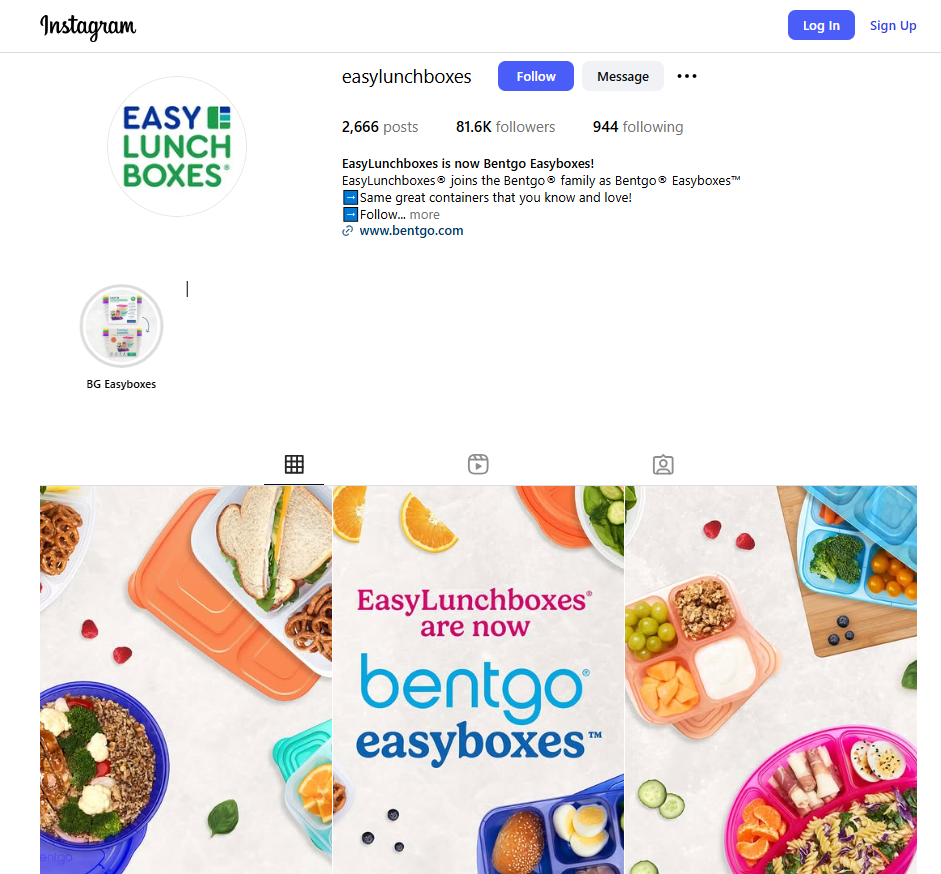
- Dollar Shave Club
Dollar Shave Club has become a case study in the world of small businesses and social media marketing. It disrupted the men’s grooming industry with its unique marketing campaigns. Ultimately, the company’s viral videos and massive popularity led to its acquisition by Unilever for whooping $1 billion.
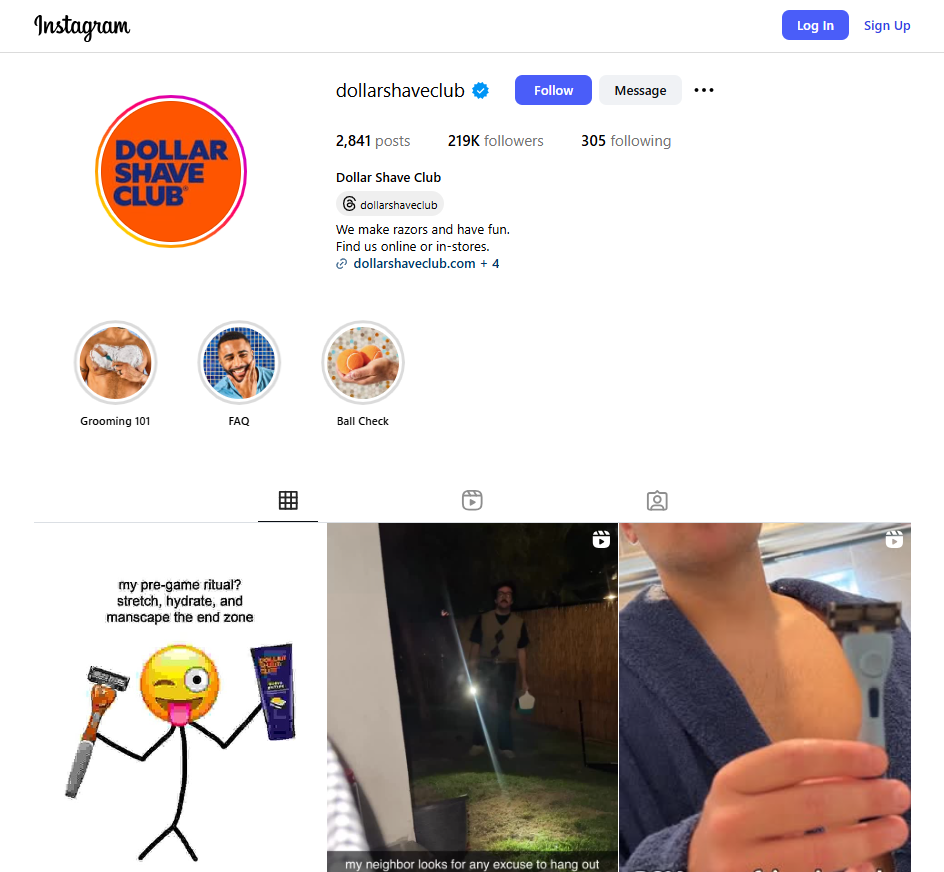
- RepairClinic.com
RepairClinic.com is the perfect example of how local small businesses can become popular worldwide with the help of social media. It started as a Michigan-based auto repair shop but soon became a trustable and reliable platform on which people can get comprehensive tutorials to resolve their vehicle issues.
The company has a focused social media marketing strategy, with Facebook and YouTube being the primary platforms. This is the right social media usage, as long video-based tutorials are perfect for a platform like YouTube.

Role of ContentStudio in social media marketing
Considering all the different aspects of social media marketing for small businesses, you must choose a reliable tool to help you in this journey. ContentStudio can do just that.
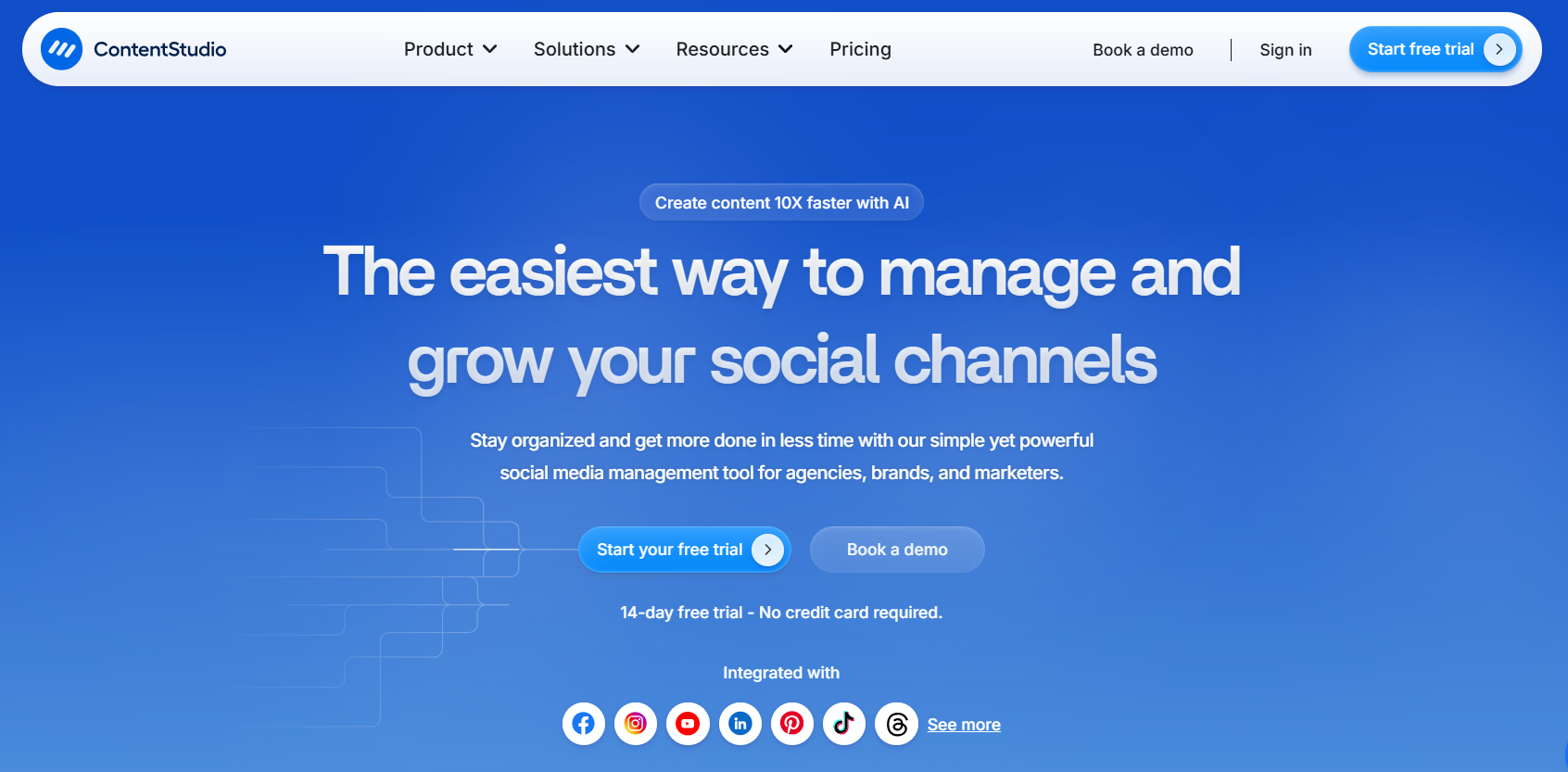
As an all-in-one social media management and marketing tool, ContentStudio can help you plan, design, implement, and track an effective social media marketing strategy for your small business.
With features like post-scheduling, content insights, influencer discovery, and AI assistance, ContentStudio is the perfect choice for end-to-end social media management. Start your free trial today to enjoy these features and take your business to the next level.
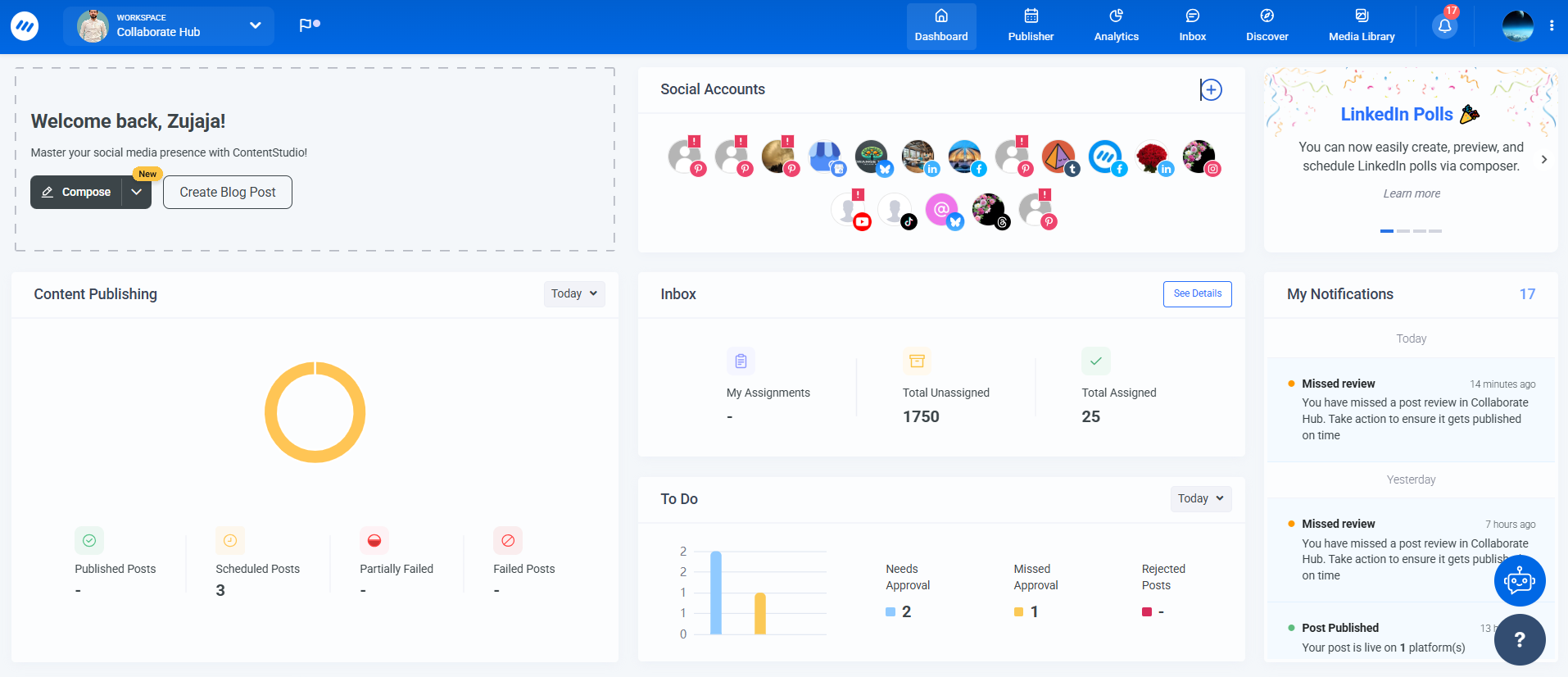
Conclusion
There is no doubt that social media is an ever-evolving landscape that can even overwhelm you. But if you follow the tips, ideas, and detailed steps in this comprehensive guide, you can establish a strong social media presence for your small business.
Ultimately, social media platforms are all about building relationships. And to do that, you should focus on providing genuine and valuable content. Showcasing the heart and soul of your small business will help you connect with your target audience and cultivate a loyal following.
With a strategic social media marketing approach, a sprinkle of creativity, and a commitment to learning and adapting, you can make your small business a huge success.
FAQs
Explain how social media has impacted marketing for small businesses.
Social media marketing has proven to be highly effective for most small businesses. It allows for direct customer interaction, broad reach, and valuable insights. Moreover, small businesses can build brand awareness, foster loyalty, and compete more effectively with larger companies with the power of social media.
How do I start marketing my small business on social media?
The basic steps involved in starting social media marketing for a small business are:
- Set goals: What do you want to achieve (brand awareness, sales, etc.)?
- Know your audience: Who are you trying to reach?
- Pick your platforms: Focus on where your audience is.
- Create great content: Mix up visuals, videos, and interesting text.
- Be consistent: Regularly post fresh content to keep people engaged.
- Talk to your audience: Respond to comments and messages and join conversations.
- Learn and adapt: Track your results and keep improving your strategy.
How much does social media marketing cost for small businesses?
Cost is a significant concern for small businesses starting social media marketing. However, the beauty of social media marketing is that it can be very cost-effective. Organic reach, achieved through strategic content creation and audience engagement, requires minimal financial investment.
However, you can leverage paid advertising to reach a wider audience or achieve specific goals. The cost of social media advertising varies depending on the platform, targeting options, and campaign duration. Many platforms offer flexible budgeting options, allowing you to tailor your spending to your comfort level.
What social media platform is best for small businesses?
There’s no single “best” platform for all small businesses. The optimal choice depends on your industry, target audience, and content type.
Here’s a quick breakdown of popular platforms:
- Facebook: Versatile for most businesses.
- Instagram: Great for visual brands.
- Twitter: Ideal for real-time updates.
- LinkedIn: Best for B2B.
- Pinterest: Perfect for visually appealing products.
- TikTok: Good for engaging younger audiences with videos.
Recommended for you


Powerful social media management software
14-day free trial - No credit card required.



